Palm Beach Post RIP 12/20/2008 – Sign on Press Room Wall
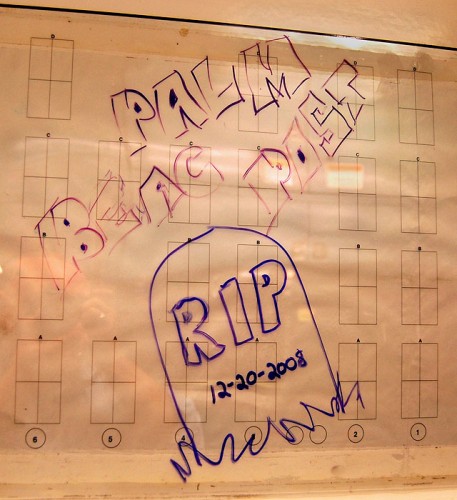 I was working as chief photographer at The Athens (OH) Messenger in the late ’60s when I decided I wanted to see what the best newspaper photo departments around the country were doing. I started subscriptions to about a dozen papers, including The Witchita Eagle-Beacon, The Louisville C0urier-Times, The Topeka Capitol-Journal, The St. Petersburg Times and The Palm Beach Post-Times.
I was working as chief photographer at The Athens (OH) Messenger in the late ’60s when I decided I wanted to see what the best newspaper photo departments around the country were doing. I started subscriptions to about a dozen papers, including The Witchita Eagle-Beacon, The Louisville C0urier-Times, The Topeka Capitol-Journal, The St. Petersburg Times and The Palm Beach Post-Times.
It became clear very early that a lot of those papers get it together for special events and projects, but their day-to-day photos and display were pedestrian, to be kind.
St. Pete and The Post looked best
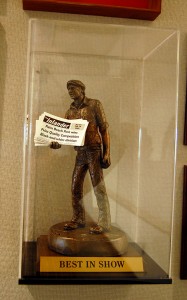 By the time I moved on to The Gastonia (NC) Gazette a couple of years later, I had let all the subscriptions lapse except St. Pete and The Post. They had the best color reproduction of any paper I had seen, but I didn’t like the way that too many of the St. Pete’s feature photos looked “too good to be true.”
By the time I moved on to The Gastonia (NC) Gazette a couple of years later, I had let all the subscriptions lapse except St. Pete and The Post. They had the best color reproduction of any paper I had seen, but I didn’t like the way that too many of the St. Pete’s feature photos looked “too good to be true.”
Now that I had moved from the Midwest to the Southeast, I was competing with Post photographers in contests and running into them at conferences.
At the end of 1972, I was flattered to receive a job offer from The Post. (I use that term generically to cover all of Palm Beach Newspapers’ publications – The Post, The Palm Beach Daily News, The Florida Pennysaver and now, La Palma.)
Did I ever have a surprise!
The photo department facilities were the worst I had ever worked in. There wasn’t a single enlarger that would hold focus for a long exposure. There weren’t enough electrical outlets, so there were extension cords poked through holes in the wall. The color film processor was homemade and an OSHA nightmare that used a Sears 3/8″ drill hanging from the ceiling to agitate the film.
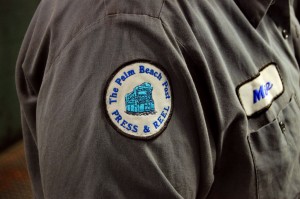 The production department might have been even worse.
The production department might have been even worse.
If I hadn’t been following the paper for a long time, I’d have packed the U-Haul and headed back to beg my old paper to take me back.
We can do this better than anybody else
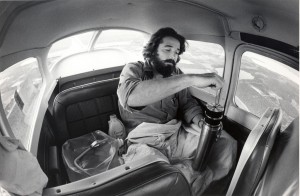 What the paper had, though, was an incredible spirit of “we can do this better than anyone else.”
What the paper had, though, was an incredible spirit of “we can do this better than anyone else.”
Long before most papers were even thinking of running color, our folks had figured out how to process film in the back of an airplane or in a car rocketing down the road.
We control our own destiny
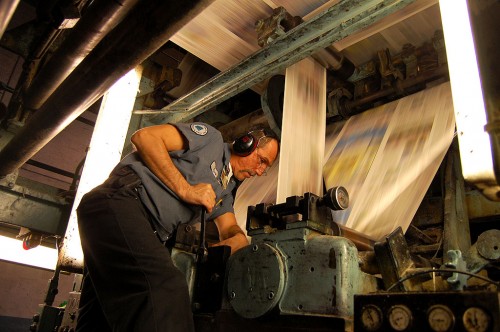 The other thing that was great about The Post was its independence. Former General Manager Lon Danielson didn’t like to be beholden to outsiders. We maintained our own presses, had our own welding shop, had our own telecom staff and computer programmers, had our own print shop, our own electrical and maintenance crews. Because they all worked for us, they had no one else setting their priorities.
The other thing that was great about The Post was its independence. Former General Manager Lon Danielson didn’t like to be beholden to outsiders. We maintained our own presses, had our own welding shop, had our own telecom staff and computer programmers, had our own print shop, our own electrical and maintenance crews. Because they all worked for us, they had no one else setting their priorities.
We’re in this together
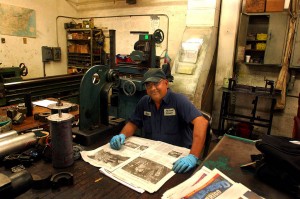 Because of this, we had a great feeling that “we’re all in this together.” If we were reconfiguring work spaces, we’d give the maintenance guys a hand with moving the cubicles and they’d pitch in to help us pull wire. Circulation folks would radio in news tips, and my staff hauled gasoline to bureau reporters in the days after hurricanes.
Because of this, we had a great feeling that “we’re all in this together.” If we were reconfiguring work spaces, we’d give the maintenance guys a hand with moving the cubicles and they’d pitch in to help us pull wire. Circulation folks would radio in news tips, and my staff hauled gasoline to bureau reporters in the days after hurricanes.
Employees risked their lives for the newspaper
The best example I saw of devotion to the newspaper came during one of the hurricanes that passed through in 2004 or 2005. The plywood panels covering air vents on the south production building were starting to peel off. If those panels had failed, the press room would have been flooded, and we’d have been out of business for no telling how long. A crew of maintenance workers used firehoses as makeshift lifelines to fight their way across the rooftop in the middle of the storm to secure the panels. You don’t get that kind of loyalty from rent-a-workers.
Breaking down silos wasn’t just a slogan
Years before “breaking down silos” became a fancy catch phrase, The Post, particularly under Lon’s leadership, offered staffers opportunities to explore new career paths and still stay at the same company. I was director of photography and ended up as telecommunications manager; the head of what was called Data Processing became general manager (Lon), and his successor was made production manager; an assistant sports editor became assistant production manager and then moved over to advertising operations. This cross-fertilization caused departments to better understand how all the pieces fit together.
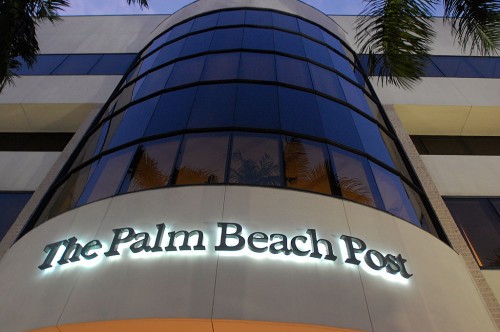 In 1995, when the newspaper moved into a fancy new four-story building, I told the Cox head honcho who came down to cut the ribbon my first impressions of the place. “The only way this place could have worked like it did was that it managed to tap into (or suck out) the souls of dedicated employees. Lord knows that everything we accomplished was in spite of, not because of the tools we had to work with.”
In 1995, when the newspaper moved into a fancy new four-story building, I told the Cox head honcho who came down to cut the ribbon my first impressions of the place. “The only way this place could have worked like it did was that it managed to tap into (or suck out) the souls of dedicated employees. Lord knows that everything we accomplished was in spite of, not because of the tools we had to work with.”
$110 Million Printing Facility Planned
After that construction project, The Post bought property near the South Florida Fairgrounds for a state of the art printing facility. It was estimated that it was going to cost about $110 million.
Then the economy stumbled
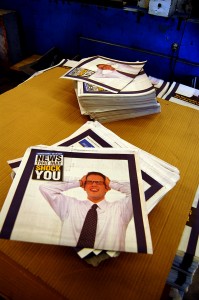 The printing facility was put on hold. The publisher retired and a new publisher was brought in. When asked when we were going to build the new facility because the old presses and mailroom equipment were getting long in the tooth, he said, “I don’t think Cox will make that kind of investment until the paper has been in the black for at least 10 years.”
The printing facility was put on hold. The publisher retired and a new publisher was brought in. When asked when we were going to build the new facility because the old presses and mailroom equipment were getting long in the tooth, he said, “I don’t think Cox will make that kind of investment until the paper has been in the black for at least 10 years.”
In August 2008, about 300 employees were offered “voluntary separations.” I was one of them.
The biggest bombshell
The biggest bombshell came close to the end of that year: The Post, which had set a standard of printing excellence for almost 40 years, was going to farm out publication to the Sun-Sentinel. Most of the distribution of the paper would be handed over to our former competitors. That cut staff by about another 300 employees. More jobs would be lost in 2009, shrinking what had been about 1,400 employees to about half that in about 18 months.
“Ask a Local” morphs into “How Can We Help You?”
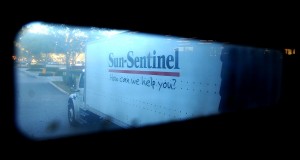 At about the same time, The Post and the other South Florida newspapers entered into “content sharing” agreements. Instead of duking out to see who could do the best job covering the news, now we would give our stories to them and vice versa. What that meant to readers was that there would no longer be two or three reporters covering a governmental meeting, providing two or three different viewpoints. Now it would be one reporter, with his or her story being printed in all of the “local” papers.
At about the same time, The Post and the other South Florida newspapers entered into “content sharing” agreements. Instead of duking out to see who could do the best job covering the news, now we would give our stories to them and vice versa. What that meant to readers was that there would no longer be two or three reporters covering a governmental meeting, providing two or three different viewpoints. Now it would be one reporter, with his or her story being printed in all of the “local” papers.
I wanted to see the magic one more time
Even though I was now at the point in my life where I had to sign in at the security desk to get a visitor’s pass to enter a place where I used to possess a “God key,” I felt a tremendous affection for the production staff who made me look good for so many years.
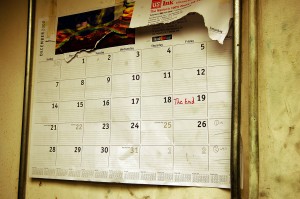 I reached out to some former coworkers who gave me tacit permission to hang out in the press room during two of the last weekends before the paper stopped being printed locally. I’ve always believed that every worker should be able to show his or her kids and grandkids what they did for a living. This is my contribution.
I reached out to some former coworkers who gave me tacit permission to hang out in the press room during two of the last weekends before the paper stopped being printed locally. I’ve always believed that every worker should be able to show his or her kids and grandkids what they did for a living. This is my contribution.
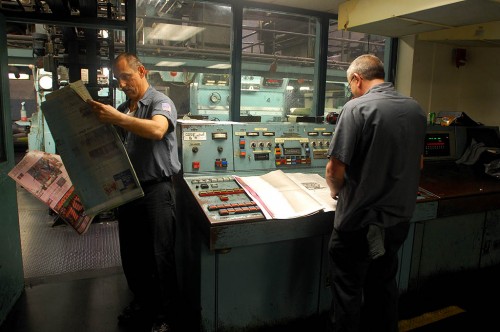 I wonder what happened to the “Last Paper”
I wonder what happened to the “Last Paper”
I’m only sorry not to have been there when the final paper came off the press. I’ve often wondered if someone saved it as a memento and what it was like to have been there when the presses rumbled to a stop for the last time. I thought about going up, but decided that that was probably a moment that needed to remain private for the men and women working there.
This gallery represents some of the folks I ran into and some details of the machinery that produced some of the finest images in the country. I’ll miss them — and the special magic of a running piece of Big Iron.
Gallery of Photos
Click on any image to make it larger, then click on the left or right side of the photo to move through the gallery.
Other newspaper stories
I frequently dredge up old war stories. Here are some that have been published during the last couple of years.
- Thoughts on the first year after retiring
- The Post 300 (first round of buyout folks) hold reunion in West Palm Beach
- Treasure Coast Post 300 hold its reunion
- Meeting my first blog reader in the wild makes me think of newspaper stories.
- The Southeast Missourian’s One-Shot Frony and my start in the business.
- An account of talking a jumper down off the Blue Heron Bridge
[Editor’s note: nothing here should be construed as being “disparaging” to The Palm Beach Post. That would violate my Voluntary Separation Program agreement. If anything, I recognize that some difficult choices had to be made in these hard economic times, even if they fall into the category of Ben Tre, a Vietnamese village that “had to be destroyed in order to save it.”
I was fortunate to have been working for newspapers – and The Post, in particular – in the days when journalism was a sacred calling.]

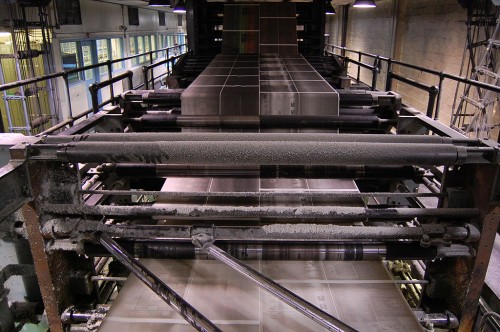





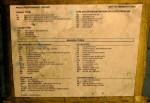













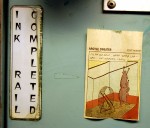






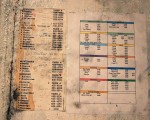

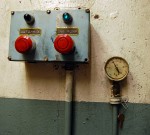




















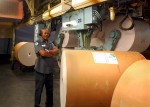



































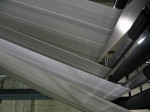













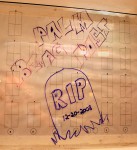
Three thumbs up!!!
Thanks for this, Ken. I think about our outstanding production staff and equipment every time I see a low quality color photo in today’s Post.
Our crew was outstanding.
Wow, a great job at documenting the implosion at one former great paper.
Thanks, Alan, David and Sally.
This one was tough for me, even harder than the pieces about the Post 300 getting together a year later.
You can always hire back reporters, editors, photographers and ad sellers, but getting rid of your production department brings back the old saw, “Freedom of the Press belongs to he who has one.”
When we lost power during the hurricanes, our staffs put their heads together and figured out how we could run our presses on generator and still keep lights on in the rest of the paper by judicious load juggling.
Do I think that a competitor would work as hard to do the same for us? Or have the ability to pull it off?
Or, worse yet, would management say, “Great. We saved the cost of a day’s production and we’ll blame it on God.” We were proud that we carried our post-storm papers to shelters and food / water distribution points because people were hungry for news.
Of course, those were the days when we were covering “news,” not generating “content.”
I really enjoyed reading about the last days of the Production dept. – my Dad worked in the Production @ The Herald, so I have a little ink in my veins as well. Even though I’ve been gone from the Post for a number of year, I still miss The Post… particularly all of the great people that I had the pleasure to worked with…
Thanks for sharing your insights…
Dear Ken,
Thank you for remembering the men and women in operations at your former employer, somehow we are often forgotten or as in your case, outsourced.
If you have your collection of photographs online I would like to link to them from my blog?
Happy Holiday’s
The Blogging Pressman
Los Angeles Times
A fantastic piece… Brings back a lot of memories of those “BIG IRON” days… as always…Great Photos !
Marvin and Tammy,
Nice to connect with some folks from the old days.
Marvin, please pass the link on to any of your old production coworkers. I’m sure some of them would like to see the pix.
Thanks for this, Ken. Although the Post looks nothing like it did when I was there, there are some things – some emotions – that feel very familiar. It’s a good friend you’re going to miss. It’s an important part of one’s history. It’s just something that has meaning I’ll never be able to describe, or forget.
How lucky I was back in 1978 to be hired by Ken Steinhoff and to work with such a fantastic staff. Thanks for the great article, the chili parties and the nod to the terrific production department.
cheers, Steve
Steve,
I’ll never forget the night you called me in the middle of a color run to tell me that your wife was going into labor well before her due date.
I’m glad everything worked out. I don’t even want to pull out the calendar and calculator to figure out how old he is.
We had some great photographers pass through The Post. We were all fortunate to work there when it was one of the best photo papers in the country.
Ken, awesome article. The Post was so much a part of all of our lives. It was a great place to work and the people who worked there made it feel like family. Although that chapter of my life has closed, it always will remain close to my heart. It was fun.
john
Thanks, Ken. Great piece.
Ken, I’m a Central ’63 grad. I’ve enjoyed reading about your work and your “retirement”… my husband Tom Schaefer worked at the Wichita Eagle (KS) for 23 years as a columnist and editor. In Dec 2006 he and many others were “offered” the severance pckg. We have followed the demise of the country’s newspaper industry closely. It was fun reading your comments.
Mary,
The death of newspapers came at a great time for me.
My boss told me that I wouldn’t be eligible for a buyout, but I convinced him that (a) I was going to retire in April of 2009 anyway, (b) I had been there 35 years, (c) that because of b I was making too much money and (d) I had been grooming my replacement for years.
I also said that I be really disappointed if I played good soldier and passed up the buyout only to find that I wouldn’t be compensated for it later on. (With my years of service, I qualified for pension, health benefits and a year’s pay.)
I agreed to stay on two weeks past the time when the first wave of 300 left to help reprogram the phone switches and voice mail systems.
It was great for us of retirement age. It’s been an struggle for the folks in the middle of their careers.
When I run into other retirees, it’s amazing to see how well we’ve adapted. One fellow I thought would die at his desk has been traveling all over the world, looks better than I’ve seen him in years and just remarried.
What a fantastic and touching tribute.
I don’t know what happened to the last paper, but I was looking around the press room just last Thursday night and noticed that, as there wasn’t anyone around to take them off the next day, the plates off which it was printed are still on the presses.
Mark,
Nice image with the exit sign in the foreground in your take.
I’d love to go back and wander the place one last time, but I’m afraid there may be a shoot on sight order out on me after I posted this. (And I don’t mean shoot with a camera.)
I wonder if Doug Franklin showed up on the last run to thank the press crews for their years of service?
I am so deeply touch by your story that I feel tears welling up in my eyes.
Connie,
Thanks for the compliment. An end of an era is worth a few tears.
Great story. The Death of a Newspaper. Sad, but the world moves on. You’re having fun and making a difference with this citizen journalism site, as am I with mine. I look at the Messenger online once in awhile, but don’t recognize anything. Those nearly three years were some of the best of my life, and the next decade was hell. For the last 20 I’ve been living a dream, traveling the world, on my own buck (very cheaply I might add) with the love of my life, on a tandem bicycle, and still taking pictures and sharing them. In addition to the site, we do multi-media presentations for charity and some magazine work together. Sounds like you had the career you wanted.
I’m having fun wandering around your site!
On the last night, I drove to The Post about 1 a.m. and walked in while the presses were running. A supervisor grabbed a fresh paper off the line and gave it to me. I still have it.
By the way … We’re. Still. Alive.
I remember the post on fern street I believe. press room was in a semi basement and walking home from school (st anns) we would stand on the sidewalk and look down into that hot and noisey room, windows were open as the time was pre air conditioning – late 40s early 50s. I often wondered if everyone who worked there suffered a hearing loss. such dedication.
Hearing loss was an occupational hazard, although hearing protection equipment was required in later years.
Newspapers used to have a great collection of sounds: the ringing bells that warned the press was starting; the low grumble it made as it got up to speed and the (literally) deafening roar when it was cranking out thousands of papers an hour.
The newsroom had the clamor of teletype machines, with their bells signaling urgent stories; the constant chatter of police radios; the sound of ringing telephones and the murmur of reporters all over the room.
The editor of my hometown paper in Cape Girardeau, MO, took the time to record those sounds before they were gone.
Nothing like the rumble of a letterpress web spitting out newspapers. And the scent of ink drying…
Ken,
I love how you bring people together with your photos and writing. You create a complete image of a time and a place important to a lot of people. Makes me wish I could have visited. So many newspapers are going away. I spend most of my time online, but I still like holding a good newspaper in my hand, browsing, bending back pages, handing a section to Claire to share something. It will be awhile before that can be created in the digital world.
When Mary Blue died, I went to The Missourian to be interviewed about her life for the article they so kindly wrote about her. What a different place….it was WAY TOO quiet! No linotypes or presses making that background noise. They actually now do the printing on William Street…..
It is funny, but I’m actually in a hotel, so I wanted to note that it was a pleasure to spend my short couple of minutes on this specific blog.
This is a wonderful, moving tribute. Well done, Ken.
Fabulous article, Ken. I surely do remember when The Evening Times did its nosedive — as eventually did most afternoon papers across the country. The entire face of journalism has changed, and there are times I long for the “old days” with good production, genuinely competitive spirits and . . . well, anyone reading Ken’s article knows what I’m talking about.
Keep the articles coming.